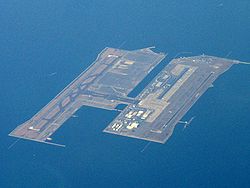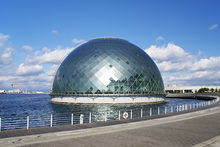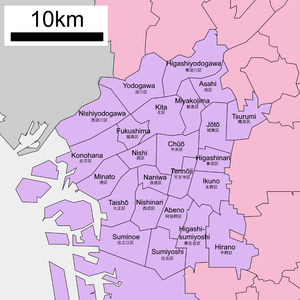Osaka
Osaka (trop市, ⋅saka-shi?Li. Big hill) (Japanese pronunciation: ![]() [ o gravesaka ] (?·i)) is the third largest city in Japan, after Tokyo and Yokohama. It is located on the main island of the archipelago, Honshū (residential), Honshū), at the mouth of the Yodo River in Osaka Bay. The city is one of Japan's most important industrial ports and centers, as well as the capital of the Osaka Prefecture. ⋅saka-fu). It is part of the Kansai region and is the core of the Osaka-Kōbe-Kioto metropolitan area (Keihanshin), which has a population of 18,644 000.
[ o gravesaka ] (?·i)) is the third largest city in Japan, after Tokyo and Yokohama. It is located on the main island of the archipelago, Honshū (residential), Honshū), at the mouth of the Yodo River in Osaka Bay. The city is one of Japan's most important industrial ports and centers, as well as the capital of the Osaka Prefecture. ⋅saka-fu). It is part of the Kansai region and is the core of the Osaka-Kōbe-Kioto metropolitan area (Keihanshin), which has a population of 18,644 000.
History
The city of Osaka was originally named as Naniwa (浪速). The name was also formerly written as 浪華 or 浪花, with the same readings. This way of writing is not very common nowadays, but there are still people who use it and it appears in Japanese historical documents. Emperor Kotoku built his own palace, the Naniwa Nagara-Toyosaki Palace, in that city and made the area the capital (Naniwa-kyō). The city served as the capital from 652 to 655, when the status was transferred to Asuka-kyō. In 744 Naniwa-kyō became the capital again by order of Emperor Shōmu, but in 745 the capital was moved to Heijō-kyō (present-day Kyoto).
Historically, Naniwa was a terminus of the seaway from the west, Kyūshū, Korea and China and a river connection between Yamato Province to the east (present-day Nara Prefecture) and Yamashiro Province to the northwest (present-day Nara Prefecture). from Kyoto). However, the sedimentation brought by the river became a problem that exceeded the technical possibilities of port maintenance in Japan in the IX century., with which Naniwa was losing importance.
In 1496, the Buddhist Jodo Shinshu sect built its headquarters in the highly fortified Ishiyama Hongan-ji temple in Ishiyama. In 1576, Oda Nobunaga besieged the temple for four years, until the monks surrendered in 1580. The temple was destroyed and Toyotomi Hideyoshi used the site to build his own castle, Osaka Castle, with which Hideyoshi is considered the founder of present-day Osaka. The city's prosperity increased during the Edo era, a period in which Osaka functioned as the economic center of Japan.
During the Tokugawa shogunate, Osaka was called Ozaka (大坂, Ōzaka). During the early Meiji era, the government renamed the city Osaka (大阪, Ōsaka), a name it retains today. Osaka continued to develop, but was gradually overtaken as a center of economic and political power with the designation of Tokyo as the nation's capital, mainly from the 19th century XXI.
Demographics
The estimated population of 2011 was 2,669,000 inhabitants, with a population density of 12,006 people per square kilometer. The total area is 222.30 km².
People in Osaka speak a dialect of Japanese called the Osaka dialect (大阪弁, Ōsaka-ben), characterized among other things by different intonation and the use of verb inflection hen (へん) or hin (ひん) instead of the standard nai (ない) for negative verb conjugation. To break the ice with someone from Osaka you can say "Osaka-ben wakarehen" which is to say "I don't understand Osaka dialect" said in Osaka dialect.
About 118,000 foreigners reside in the city, with the largest Korean community at 96,000. The Korean community is mainly concentrated in Ikuno-ku (生野区), where the Tsuruhashi Koreatown is located.
Climate
Osaka has a humid subtropical climate (Cfa in the Köppen climate classification), with four distinct seasons. There are normally mild winters, with January being the coldest month of the year with an average maximum temperature of just 9.5 °C. On rare occasions it gets to snow in the city. Spring begins already far from the mild climate of winter, but it ends up being warm and humid. As Osaka is one of the southernmost cities in Japan, it is one of the first to receive the tsuyu rains, beginning between the end of May and ending at the beginning of June. Summers are very hot and humid. In the months of August and July, the average daily temperature reaches 35 °C, while night temperatures normally reach 25 °C. During the fall, temperatures tend to drop little by little; in its first half it resembles summer weather, and in its final half, winter weather.
| Month | Ene. | Feb. | Mar. | Open up. | May. | Jun. | Jul. | Ago. | Sep. | Oct. | Nov. | Dec. | Annual |
|---|---|---|---|---|---|---|---|---|---|---|---|---|---|
| Average temperature (°C) | 9.5 | 10.2 | 13.7 | 19.9 | 24.5 | 27.8 | 31.6 | 33.4 | 29.3 | 23.3 | 17.6 | 12.3 | 21.1 |
| Average temperature (°C) | 4.7 | 5.7 | 9.4 | 14.7 | 19.7 | 23.5 | 27.4 | 28.8 | 25.0 | 19.0 | 13.0 | 8.2 | 16.6 |
| Temp. medium (°C) | 2.8 | 2.9 | 5.6 | 10.7 | 15.6 | 20.0 | 24.3 | 25.4 | 21.7 | 15.5 | 9.9 | 5.1 | 13.3 |
| Total precipitation (mm) | 45.4 | 61.7 | 104.2 | 103.8 | 145.5 | 184.5 | 157.0 | 90.9 | 160.7 | 112.3 | 69.3 | 43.8 | 1279.0 |
| Nevadas (cm) | 1 | 1 | 0 | 0 | 0 | 0 | 0 | 0 | 0 | 0 | 0 | 0 | 3 |
| Precipitation days (≥ 1.0 mm) | 5.6 | 6.3 | 9.9 | 9.3 | 10.0 | 11.2 | 9.9 | 6.9 | 9.4 | 7.9 | 6.2 | 5.5 | 98.1 |
| Days of snowfall (≥ 1 mm) | 5.0 | 6.3 | 2.3 | 0.0 | 0.0 | 0.0 | 0.0 | 0.0 | 0.0 | 0.0 | 0.0 | 1.9 | 15.5 |
| Hours of sun | 142.6 | 135.4 | 159.5 | 188.6 | 194.3 | 156.2 | 182.1 | 216.9 | 156.7 | 163.9 | 148.5 | 151.6 | 1996.4 |
| Relative humidity (%) | 61 | 60 | 59 | 59 | 62 | 68 | 70 | 66 | 67 | 65 | 64 | 62 | 64 |
| Source No. 1: Japan Meteorological Agency | |||||||||||||
| Source No. 2: World Meteorological Organization (rainy days) | |||||||||||||
City landscape
Economy
The Gross Domestic Product (GDP) of the city of Osaka in fiscal year 2004 was 21,300,000,000,000 yen, an increase of 1.2% over the previous year. The figure represents around 55% of the total production in Osaka Prefecture and 26.5% in the Kinki region. In 2004, trade, services, and manufacturing were the three largest industries, accounting for 30%, 26%, and 11% of the total, respectively. The city's per capita income was around ¥3.3 million, 10% higher than that of Osaka Prefecture. that it plays an important role in the global economy.
GDP in the Osaka metropolitan area (Osaka and Kobe) is $341 billion. Osaka, along with Paris and London, has one of the most productive hinterlands in the world. Historically, the city was the center of commerce in Japan, especially in the Middle Ages and pre-modern.
Many large companies have already moved their headquarters to Tokyo. However, several major companies such as Panasonic, Sharp, and Sanyo are still headquartered in Osaka. The city recently started a program, spearheaded by Mayor Junichi Seki, to attract foreign and domestic investment.
Politics
The Osaka City Council is the local government of the city, formed under the Local Autonomy Law. The Council has eighty-nine seats, assigned to the twenty-four districts proportional to their population and re-elected by the citizens every four years. The Council elects its president and vice-president. Toshifumi Tagaya (PLD) has been the current president since May 2008. The mayor of the city is directly elected by the citizens every four years, in accordance with the Local Autonomy Law. Toru Hashimoto, former Governor of Osaka Prefecture, has been the mayor of Osaka since 2011. The mayor is supported by two deputy mayors, currently Akira Morishita and Takashi Kashiwagi, who are appointed by him in accordance with municipal ordinance. Osaka is also home to various agencies of the Japanese Government.
Sports
Baseball
Osaka has two major baseball teams, both in the Japan Professional Baseball League:
- Orix Buffaloes, who play at the Osaka Dome and who exist with such a name since 2005, emerging from the merger of two previous clubs, Orix Blue Wave and Osaka Kintetsu Buffaloes; his oldest ancestor, then, is the team called Osaka Hankyu, which emerged in 1936. As part of its history, only the titles obtained from the Orix Blue Wave are accounted for, while those of the Kintetsu Buffaloes are considered achievements of a different team, already missing. Therefore, the Orix Buffaloes has twelve Pacific League titles and four Japan Series titles (both obtained more recently in 1996). However, it has not obtained any title since it exists with its current name.
- Hanshin Tigers, who play at Koshien Stadium, except for some matches that they play at Osaka Dome, usually in August, which is when their regular stadium is occupied. They emerged in 1936 as Osaka Tigers and changed to their current name in 1961. They play in the Central League, of which they have been champions five times (the most recent in 2005), as well as having won a Japan Series championship in 1985.
Football
The city has two professional soccer teams: Gamba Osaka and Cerezo Osaka.
- Gamba Osaka. It is the most recognized team in the city of Osaka, counting on its displays with many national and international titles. Founded in 1980 as Matsushita Electric Industrial Football Club, under this denomination won the Emperor’s Cup in 1990. In 1993 he joined the J. League as one of the 10 original founding members of Division 1. Play as a local in the Suita Football Stadium, a modern stadium for 40,000 sitting spectators.
- Cerezo Osaka. Founded in 1957 as Yanmar Diesel Football Club. Under this denomination he won the league championship on four occasions (for the last time in 1980) and the Emperor’s Cup in three (more recently in 1974); in 1995 he joined the nascent J. League, in which he has participated since interscaling between Division 1 and Division 2. He plays his games at Kincho Stadium.
Summo
The Haru Basho (春場所) or Spring Tournament, also known as Sangatsu Basho (三月場所), is the second annual sumo tournament held in Osaka in March.
Transportation
Air
Kansai International Airport is the main airport, located on a rectangular artificial island built in Osaka Bay, and is used by Osaka and the surrounding cities of Nara, Kobe, and Kyoto, among others. Kansai (関西) is the geographical term used for the western area of Honshu. The airport is connected by bus and train services to the city center and major suburbs. The oldest Osaka International Airport, at Itami, continues to function for domestic flights.
Sea
The port of Osaka serves as the shipping hub for the Kansai region, along with the port of Kobe.
Transportation of people
Osaka's ferry connections are much better than those of Tokyo due to its location, closer to other regions of the Asian continent. There are international ferries connecting Osaka with Shanghai, Tianjin, Korea and recently Taiwan. In addition, there are regular national ferries connecting Osaka with Kitakyushu, Kagoshima, Miyazaki and Okinawa.
Transportation of goods
Osaka Port's freight transport plays an important role in domestic and international shipping, as its export and import areas span the entire globe. Although the port of Kobe in 1970 became the busiest on the planet, it did not appear in the top 20 again. Likewise, the Kansai area has 5 gas pipelines.
Osaka Subway
There is also a widely used subway network, the Osaka subway, with 880 million passengers each year, making it the eighth most used network in the world. It was opened in 1933. In addition, there are train networks of both the Japan Railways company and other private companies, which connect the suburbs of the city and Osaka with its neighboring cities.
Culture
Osaka has an important cultural life, in which the Philharmonic Orchestra stands out.
Museums
The National Museum of Art or National Museum of International Art (NMAO) is an underground museum of international art, housing mainly post-war collections and regularly displaying temporary exhibitions. The Osaka Science Museum is located next to the National Museum of Art, and features a planetarium and an OMNIMAX theater. The Oriental Ceramics Museum has more than 2,000 pieces of ceramics from China, Japan, Korea and Vietnam, and among its main pieces are some celadon pieces from Korea exposed under natural light. The Osaka Municipal Museum of Art is located in Tennōji Park, and features 8,000 Japanese and Chinese paintings and sculptures. The Osaka Maritime Museum, opened in the year 2000, is accessed only through an underwater tunnel that leads to its dome. The Osaka History Museum, opened in 2001, is housed in a modern building that provides a glimpse of Osaka Castle. Its exhibitions cover the history of the city, from Prehistory to the present. The Osaka Museum of Natural History houses a collection linked to natural history and life.
Education
Universities
Because it is the largest city in the Kansai region in Osaka there are a good number of universities, some of them are:
- University of Kansai
- University of Osaka
Tourism
Osaka is divided into northern (北, kita) and southern (南, minami) sections. The commercial area of the Umeda (梅田) district is located in the north, while the entertainment area around the Dotonbori Bridge (道頓堀橋, dōtonboribashi) in Namba is located in the south of the city. city. The south is also home to the Shinsaibashi and Tenjinbashi shopping malls. The financial and legal centers are located between the north and the south, mainly in Yodoyabashi and Honmachi.
Osaka is famous for its bunraku (traditional puppet theatre), kabuki theater, and manzai, a contemporary form of comic dialogue. In addition, it is known for being the hometown of the members of a famous modern enka musical group, Kanjani8.
Among the main tourist attractions are:
- The castle of Osaka ⋅saka-jō), considered the most visited tourist attraction of all Japan, both by local and foreign tourists.
- The aquarium of Osaka Kaiyūkan), an aquarium located in Osaka Bay and opened on 20 July 1990. It is under roof and is considered one of the largest in the world, as it contains 30,000 specimens of 620 different species, both fish and amphibians, reptiles, birds and mammals, as well as invertebrates and plant species. They are distributed in 14 tanks with a total capacity of 11 tons of water, being their largest tank, with 5400 tons of water, also the largest in the world. Their exhibitions focus on the Pacific Ocean species, representing a total of ten regions of both the Fire Belt and the so-called Pacific Life Zone. The place is established in such a way that it simulates a journey from the earth's surface to the bottom of the sea, trying to represent what would be an excursion in the real environment.
- The Shinsekai district (blessing prize) and the Osaka tower (transfer,, Tsūtenkaku).
- Numerous fun and theme parks, including the Universal Studios Japan, and Expoland.
- The Museum of the city of Osaka.
- The Municipal Museum of Oriental Ceramics.
- Sumiyoshi Park.
Neighborhoods
Osaka has 24 neighborhoods or chiku (地区, chiku, literally section, or sector). Neighborhood names are followed by the suffix ku (区).
International relations
Sister Cities
Osaka has 8 sister cities and four friendship and cooperation treaties:
Sister ports
The city of Osaka is twinned with other port cities:
Business partner cities
Business partner cities with Osaka are:
Contenido relacionado
Olvera
Olmec culture
Pacific War












